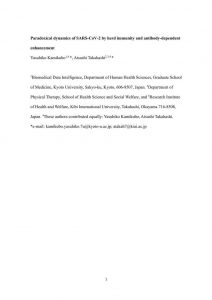Fri May 15 14:09:53 2020
<8f79fcda> <https://www.cambridge.org/engage/coe/article-details/5ead2b518d7bf7001951c5a5|https://www.cambridge.org/engage/coe/article-details/5ead2b518d7bf7001951c5a5>
— Paradoxical dynamics of SARS-CoV-2 by herd immunity and antibody-dependent enhancement
— The outbreak of SARS-CoV-2 in Wuhan, China caused a pandemic of COVID-19. However, it remains enigmatic why the mortality rate is variable among countries. Here we show that at least three types of SARS-CoV-2 virus, type S, K, and G. have spread globally and formed complex infectious trends in terms of transmissibility and virulence. Type K establishes herd immunity and protects against the most virulent type G. Immunity to type S is involved in aggravating type G infections through antibody-dependent enhancement (ADE). Epidemiological tools based on influenza and SARS-CoV-2 epidemic curves explain why COVID-19 mortality varies among Japan prefectures and European countries, and warns of high fatality in the United States. An equation was developed to quantify the severity of COVID-19. Our tools and equations also detect new infectious disease explosions and bioterrorism early, and guide containment of the virus with therapeutic approaches and local policies efficiently inducing herd immunity.
